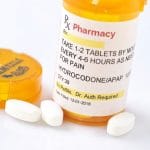- What Is Oxycodone Abuse & Addiction?
- Signs Of Oxycodone Addiction
- Oxycodone Addiction Treatment Options
- Frequently Asked Questions
Oxycodone is an opioid analgesic (painkiller) that treats moderate to severe pain, including chronic pain, cancer pain, and post-surgery pain. It’s prescribed under the brand name OxyContin. In addition, it’s an ingredient in the popular pain medication Percocet.
Like other prescription opioids, oxycodone poses a high risk of abuse and addiction.
What Is Oxycodone Abuse & Addiction?
Oxycodone abuse occurs when you use oxycodone in a manner not prescribed by your doctor. For example, many people abuse the drug by taking it without a prescription, taking higher doses than prescribed, or crushing the pills and snorting them.
Abusing oxycodone can make you feel relaxed and euphoric. However, it also poses serious health risks, including:
Increased Side Effects
The most common side effects of oxycodone include drowsiness, headache, stomach pain, dry mouth, and mood changes. You’re more likely to experience these effects if you abuse the drug. You may also experience rarer, more serious side effects, such as:
- fever
- nausea and vomiting
- diarrhea
- loss of appetite
- dizziness
- confusion
- agitation
- hallucinations (seeing, hearing, or feeling things that aren’t there)
- heartbeat changes
- chest pain
- trouble breathing or swallowing
- swollen face, throat, lips, tongue, eyes, hands, lower legs, or feet
- loss of coordination
- seizures
Overdose
Like other types of opioid abuse, oxycodone abuse often leads to overdose. Common symptoms of oxycodone overdose include:
- cold, clammy skin
- change in pupil size
- trouble breathing
- weak muscles
- extreme drowsiness
- loss of consciousness
When left untreated, an oxycodone overdose can be fatal. It’s particularly dangerous if you bought the drug on the street. That’s because many drug dealers lace oxycodone with fentanyl, which is an even stronger opioid that’s been linked to numerous overdose deaths.
Opioid Use Disorder
Many people who abuse oxycodone become addicted to it. Opioid use disorder, or addiction, can also occur if you take the drug as prescribed for a long period of time. In either case, oxycodone addiction is a serious disease that makes you feel unable to stop using the drug.
Signs Of Oxycodone Addiction
One of the most common signs of oxycodone addiction is physical dependence. When you’re physically dependent on oxycodone, your body can’t function without it. If you stop using it, you may experience withdrawal symptoms such as:
- anxiety
- irritability
- yawning
- trouble sleeping
- runny nose
- water eyes
- nausea and vomiting
- diarrhea
- stomach cramping
Other signs of oxycodone addiction include:
- tolerance (needing increasingly larger or more frequent amounts of oxycodone to feel the desired effects)
- withdrawing from friends and family members
- losing interest in activities once enjoyed
- falling behind at work or school
- acting moody or secretive
- visiting multiple doctors to get multiple prescriptions of oxycodone (also called “doctor shopping”)
Oxycodone Addiction Treatment Options
If you think you or someone you love is addicted to oxycodone, seek help at a substance abuse treatment program.
There are both inpatient programs (which involve living at the treatment facility) and outpatient programs (which involve regularly visiting the treatment facility while living at home).
In general, inpatient programs are recommended for people with moderate-to-severe addictions, while outpatient programs can work for people with milder addictions and strong support systems at home.
When you enter the treatment program, a team of medical professionals will design a treatment plan tailored to your needs. This plan may include services such as:
Medical Detoxification
Almost all treatment plans start with medical detoxification (also called detox). During detox, you’ll gradually stop using oxycodone under the care and supervision of medical professionals.
They’ll monitor your health and, in some cases, prescribe medications to ease withdrawal symptoms such as nausea and anxiety.
Medication-Assisted Treatment (MAT)
After completing detox, many people move on to medication-assisted treatment (MAT). During MAT, doctors will prescribe medications to help you recover more quickly and comfortably. These medications may include:
- buprenorphine, which reduces opioid cravings
- methadone, which reduces opioid cravings and withdrawal symptoms
- naltrexone, which blocks the pleasant effects of opioids
MAT also includes mental health counseling.
In counseling, you’ll learn how to cope with triggers, which are people, places, or other things that make you abuse oxycodone. Your counselor can also help you manage any stressors or mental health conditions that may have contributed to your prescription drug abuse.
Support Groups
When recovering from oxycodone addiction, you might feel like no one understands what you’re going through. In a support group, you’ll meet other people who are facing similar challenges.
You can also receive important coping tips that will help you stay sober once you leave the program.
Wellness Activities
To recover from any type of drug addiction, you have to take care of yourself. That’s why many treatment programs offer activities that boost your well-being, such as exercise, meditation, and arts and crafts.
When treatment ends, you can reduce your risk of relapse by making these activities part of your regular routine.
If you or a loved one struggles with oxycodone use, please reach out to Northeast Addictions Treatment Center. We provide comprehensive, personalized services to help people recover from opioid addiction and other substance use disorders.
Frequently Asked Questions
What Does Oxycodone CWE Mean?
Oxycodone CWE is short for oxycodone cold water extraction, a form of drug tampering where oxycodone is taken out of combination products and then ingested. Tampering with drugs through CWE is illegal, and can be hazardous to your health.
Learn more about Oxycodone CWE
How Long Does Oxycodone Stay In Your System?
Oxycodone stays in a person’s system for up to 30 hours but metabolism, body composition, and patterns of drug use can affect elimination times.
Your body turns oxycodone into two major metabolites: noroxymorphone and noroxycodone. These metabolites can be detected in blood for about 24 hours, in saliva for about 48 hours, in urine for up to 3 days, and in hair for 90 days.
To learn more, read How Long Does Oxycodone Stay In Your System
What Happens When You Snort Oxycodone?
If oxycodone medications are ground into a fine powder and snorted, the full dose of the medication will be swiftly absorbed through the mucus membranes of the sinuses, resulting in an intense high.
However, this form of drug abuse increases the risk of dangerous infections, harmful or deadly overdose, opioid addiction, and severe sinus injuries over time.
Learn more about Snorting Oxycodone
Can You Smoke Oxycodone?
Yes, oxycodone can be smoked. However, it’s dangerous and can cause wheezing, coughing, respiratory depression, dizziness, and an increased risk of overdose.
Learn more about Smoking Oxycodone
What Are The Risks Of Injecting Oxycodone?
Injecting oxycodone raises the risk of side effects and opioid overdose. It can also cause:
- skin infections, which may lead to tissue death that necessitates limb amputation
- infection in the heart lining, valves, or blood vessels from bacteria that enters the bloodstream through drug injection
- transmission of bloodborne diseases like HIV and Hepatitis C from sharing needles and other unsafe drug-related behavior
- a higher likelihood of addiction and physical dependence
- more intense withdrawal symptoms if you try to stop using it abruptly
Learn more about Injecting Oxycodone
Sources
Written by
Northeast Addition Editorial Team
©2024 Northeast Addition Center | All Rights Reserved
This page does not provide medical advice.




